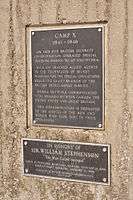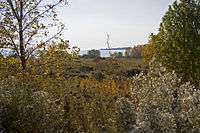Camp X
| |
|---|---|
| Near Whitby, Ontario in Canada | |
|
Camp X in 1943 | |
 Camp X Shown within Ontario | |
| Coordinates | 43°51′15″N 078°53′06″W / 43.85417°N 78.88500°WCoordinates: 43°51′15″N 078°53′06″W / 43.85417°N 78.88500°W |
| Type | Training installation |
| Site history | |
| Built | December 6, 1941 |
| In use | 1941–1969 |
| Fate | Destroyed |
| Garrison information | |
| Past commanders | Sir William Stephenson |
| Occupants |
|
Camp X was the unofficial name of a Second World War paramilitary and commando training installation, on the northwestern shore of Lake Ontario between Whitby and Oshawa in Ontario, Canada. The area is known today as Intrepid Park, after the code name for Sir William Stephenson of the British Security Coordination.
Overview
Camp X was established December 6, 1941 by the chief of British Security Coordination (BSC), Sir William Stephenson, a Canadian from Winnipeg, Manitoba and a close confidant of Winston Churchill and Franklin Delano Roosevelt.[1] The camp was originally designed to link Britain and the US at a time when the US was forbidden by the Neutrality Act to be directly involved in World War II.
Before the attack on Pearl Harbor and America's entry into the war, Camp X opened for the purpose of training Allied agents from the Special Operations Executive, Federal Bureau of Investigation, and American Office of Strategic Services (OSS) intended to be dropped behind enemy lines as saboteurs and spies. However, even before the United States entered the war on December 7, 1941, agents from America's intelligence services expressed an interest in sending personnel for training at the soon to be opened Camp X. Agents from the FBI and the Office of Strategic Services (forerunner of the CIA) secretly attended Camp X. Most notable was Colonel William "Wild Bill" Donovan, war-time head of the OSS, who credited Sir William Stephenson with teaching Americans about foreign intelligence gathering. The CIA even named their recruit training facility "The Farm", a nod to the original farm that existed at the Camp X site.
Camp X was jointly operated by the BSC and the Government of Canada.[1] The official names of the camp were many: S 25-1-1 by the Royal Canadian Mounted Police (RCMP), Project-J by the Canadian military, and Special Training School 103 by the Special Operations Executive, administered under the cover of the Ministry of Economic Warfare (MEW). In 1942 the Commandant of the camp was Lieutenant R. M. Brooker of the British Army.[2]
Camp X trained over five hundred Allied units, of which 273 graduated and moved on to London for further training. Many secret agents were trained here.[1] The Camp X pupils were schooled in a wide variety of special techniques including silent killing, sabotage, partisan support and recruitment methods for resistance movements, demolition, map reading, use of various weapons, and Morse code.
It was at Camp X that the OSS operated an "assassination and elimination" training program that was dubbed "the school of mayhem and murder" by George Hunter White, who trained at the facility in the 1950s.[3]
Hydra
One of the unique features of Camp X was Hydra, a highly sophisticated telecommunications centre.[1] Given the name by the Camp X operators, Hydra was valuable for both coding and decoding information in relative safety from the prying ears of German radio observers and Nazi detection.[1] The camp was an appropriate location for the safe transfer of code due to the topography of the land; Lake Ontario made it an excellent site for picking up radio signals from the United Kingdom. Hydra also had direct access via land lines to Ottawa, New York City and Washington, D.C. for telegraph and telephone communications.[1] The main transmitter was previously used as that of American AM station WCAU's shortwave sibling W3XAU, and upon severance of W3XAU in 1941, the transmitter was refurbished and became the transmitter for Hydra. Other radio apparatus was purchased discretely from amateur radio enthusiasts, brought to the building in pieces and assembled on site.[4] The transmitter was scrapped in 1969.
Postwar
Trainees may have included Ian Fleming, later famous for his James Bond books, though there is evidence against this claim.[1][5] The character of James Bond was supposedly based on Sir William Stephenson and what Fleming learned from him.[1] Children's writer Roald Dahl and British screenwriter Paul Dehn also trained at the camp.[6]
In the fall of 1945 Camp X was used by the RCMP as a secure location for interviewing Soviet embassy cypher-clerk Igor Gouzenko, who defected to Canada on September 5 and revealed an extensive Soviet espionage operation in the country.
Post-war, the camp was renamed the Oshawa Wireless Station and was turned over to the Royal Canadian Corps of Signals as a wireless intercept station, in essence a spy listening station. The Oshawa Wireless Station ceased operations in 1969. All remaining buildings were demolished or relocated elsewhere and the property abandoned. Records pertaining to Camp X were either locked away under the Official Secrets Act or destroyed after World War II.
Nothing significant remains of Camp X today, as all the remaining buildings were bulldozed into Lake Ontario in 1969 when the camp was decommissioned, although several craters from explosives training are still visible. The site, located on Boundary Road in Whitby, Ontario, is now a passive park named "Intrepid Park". A monument was erected in 1984 to honour the men and women of Camp X, which many in the intelligence world consider to be the finest espionage training camp of the Second World War. The monument is surrounded by four flags: the Bermuda flag (where Stephenson died), the flag of the United States, the British Union Jack, and the current flag of Canada. In recent years it has been the site of annual Remembrance Day ceremonies hosted by 2 Intelligence Company, a military intelligence unit based in Toronto, Ontario.
Artifacts from the spy camp are still occasionally found in the park. In August, 2016, a hobbyist with a metal detector uncovered a rusty World War II smoke mortar round, triggering a visit from Canadian Forces Base Trenton's bomb disposal team.[7]
Gallery
-

Monument at the site of Camp X in Whitby, Ontario.
-

Plaques on a monument at the site of Camp X in Whitby, Ontario.
-

A view of part of the site of Camp X looking toward Lake Ontario.
References
- 1 2 3 4 5 6 7 8 Walters, Eric (2002). Camp X. Toronto: Puffin Canada. p. 229. ISBN 0-14-131328-5.
- ↑ Stafford, David. Camp X: Canada's School for Secret Agents. (centre section, unpaged). Lester & Orpen Dennys, 1986.
- ↑ Albarelli, H. P., Jr. (2009). A Terrible Mistake: The Murder of Frank Olson and the CIA’s Secret Cold War Experiments. Walterville, OR: TrineDay Publishers. pg. 67. ISBN 0-9777953-7-3.
- ↑ "Hydra", in Lynn-Philip Hodgson, Inside - Camp X, 2000, pages 77-84.
- ↑ Chancellor, Henry (2005). James Bond: The Man and His World. John Murray. ISBN 0-7195-6815-3.
- ↑ Conant, Jennet (2008). The Irregulars: Roald Dahl and the British Spy Ring in Wartime Washington. Simon & Schuster. ISBN 978-0-7432-9458-4.
- ↑ "Fire in the hole: Whitby man finds Second World War mortar bomb in lakefront park" (print version headline: "Whitby man finds Second World War bomb under park". Toronto Star, August 26, 2013. by Christopher Reynolds.
